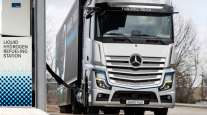Detroit Reman Offers More Parts Choices from Daimler in North American Aftermarket
This story appears in the July 16 print edition of Transport Topics.
TOOELE, Utah — As soon as Daimler Trucks offers its North American customers a new part or system, the corporation’s remanufacturing unit, Detroit Reman, is already figuring out how to get used versions of them as soon as possible, so the division can remanufacture them and sell them on the aftermarket.
The president of Detroit Reman said he is trying to increase the range of parts he reconditions at six North American plants — five in the United States and one in Toluca, Mexico — and that when Freightliner and Western Star owners buy replacement parts for their trucks, the price includes a 20% to 40% core deposit that is refunded when the part is returned for remanufacturing.
Remanufacturing works best as a regional activity, said Stefan Kürschner, head of the reman unit. It would be too expensive, for example, to ship cores to China for processing and then back for aftermarket distribution, so his branches cover a range of products from whole engines to transmissions, fuel systems, electronics, water and fuel pumps, air compressors and turbochargers, and diesel particulate filters.
“Remanufacturing is not just washing and reassembling,” said Kürschner at a July 10 press tour
of his plant here. “It’s about the recovery of materials, remachining and cleaning that is really precision washing.”
Comparing costs of making a new part or remanufacturing one, Daimler Trucks said remanufacturing uses 85% less energy, produces 53% less carbon dioxide and sends 75% less waste to a landfill.
Detroit Reman said that, in 2011, it recycled 8,018 tons of metal, 1,062 tons of cardboard, 12 tons of other paper and 27 tons of plastic.
Old parts, known as cores before they are remanufactured, go through a quick visual inspection upon arrival at the plant. About 20% to 30% fail the initial inspection and are sold off to scrap dealers.
Detroit Reman employs about 1,430 people — 9% of DTNA’s total workforce — at its six North American plants. Kürschner declined to provide an annual revenue figure. The main office is in Redford, Mich.
Byesville, Ohio, is the division’s largest plant, with more than 500 employees, and does a lot of work on the Series 60 truck engine rebuilds. Tooele is second-largest, with about 330 workers, and mainly works on turbochargers and off-highway S-series engines, used in hydraulic fracturing and marine applications.
Not only does Daimler remanufacture many of its own parts and components, but also does some parts made by competitors. Plant manager Richard Cox said he and his staff have to reverse-engineer items when they don’t have the original specifications.
To accomplish that, the plant has a $460,000 Zeiss multi-application sensor system that records shapes and sizes on new parts, creating a guide for the reman process. The Zeiss machine records to within two microns, or two millionths of a meter. By comparison, Cox said, a human hair is about 75 microns in diameter.
The plant also uses computer numerical control, or CNC machine tools, to return turbocharger blades to their original shape.
While remanufacturing uses only a small fraction of the metal a new part would require, applying the small quantities of metal needed is done through sophisticated methods.
A twin-wire process takes two electrically charged wires — often a nickel-steel combination — and liquefies pieces of them, and then the molten metal is sprayed into place with an inert gas.
The company also uses a submerged arc welding process to rebuild a thicker layer of metal. Hot flux gets flooded over the area that needs to be rebuilt.
For diesel particulate filters, standard emissions equipment on trucks since 2007, the company learned that soot can easily get blown away with compressed air, but ash is sticky and has to be washed with a water-based solution.
Detroit Diesel Corp. has been doing remanufacturing since the 1960s, when it was part of General Motors Corp. Roger Penske, a former part owner, saw the value in it and created DDC Remanufacturing Corp. in the 1990s, Kürschner said.
The Tooele plant was built by the Army in the early 1990s and converted to commercial use by Penske in 1996.
Tooele also uses bake ovens, a frequently used technique in remanufacturing (6-25, p. 24). They usually fire up to about 850 degrees Fahrenheit to burn off oil and paint from old parts, and for some processes reach 1,300 degrees.
For fuel systems, the company has avoided the need to reverse engineer by organizing the branch in Kentwood, Mich., as a joint venture with the Bosch Group, the makers of the original systems.
Kentwood includes fuel pumps and injectors and common-rail fuel systems.
The Hibbing, Minn., plant veers away from traditional heavy manufacturing by working on electronics systems, including motherboards, power inverters and automatic transmission electronics.
In addition to its truck work, Tooele also remanufactures large, off-highway engines in limited quantities. Each cylinder has four liters of displacement and engines may have up to 20 cylinders, for a total of 80 liters — much bigger than the largest Detroit truck engine, the 16-liter DD 16.




